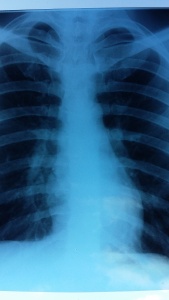
Inside Yoga 247 (29/10/2018)
One of the biggest barriers to yoga practice is being distracted and lost in thought, with our mind travelling far away from our body into long storylines of memories or plans for a future. Developing x-ray vision is a good way bringing us back and re-connecting with our body and breathing.
When we practice yoga we are asked to focus on our body and breathing as a way of increasing our concentration levels and quietening the restlessness of body and mind. If we use our imagination and focus to picture our skeleton while practising yoga we will notice how it not only helps us to concentrate and settle the mind, but it will also improve our understanding of what we are doing, and as a result of this deep focussing we will be able to improve the alignment and efficiency of the posture.
It does not really matter if we feel our x-ray vision is poor, because the effort and intention will make a difference, because by focussing on the skeleton we are giving our posture structure and something tangible to hold on to. After all, without a skeleton we would be a bob of jelly.
There are times when there is a gap between what we are trying to focus on and what is achievable, and this can happen if we are asked to aim for something that feels esoteric and distant, like an imagined perfect state of mind, when it is far simpler to focus on our body and its core, the skeleton, which is real and something we can all understand and picture, even if we don’t rate the power of our own imagination.
Here is the paradox: We are more likely to achieve this perfect state of mind mentioned above, where we have stillness, clarity and a feeling of well-being, if we place our attention on something else, that is, our body’s skeleton, because by increasing our concentration levels on the skeleton, we quieten and sharpen the mind and our senses, and as a result we might find ourselves resting in the perfect state of mind mentioned… even though we did not directly seek it.
This emphasis on mindfulness of the body is deepened by focussing internally and we will notice as we develop this x-ray vision we become more aware of the muscles which support the skeleton, and further down the line of inquiry we will have a greater awareness of our organs, and their function, for example, the heart and lungs quietly working away without interruption.
When we focus on our body like this we will not be passive in our observations, because what comes with awareness is the action to improve the posture, because by bringing attention to our skeleton while in a posture we will notice more clearly what can be improved. For example, in a seated forward bend we might notice that our feet are not upright, in dorsiflexion (flexion of the foot in an upward direction) and take action to improve this, and then we will notice how this helps us to straighten our legs (and the bones within), and so forth up through our body.
This methodology is simple but an effective way of deepening our practice, but it also helps us to notice things in daily life, like our body posture which an so often be in poor alignment. For example, when seated and walking for example, all we need to do is pay attention to our body and its skeleton and notice what are we doing… and then improve it. A slouching posture can make us feel sleepy and possibly depressed, but by simply sitting up we will wake up a bit and help improve how we feel. When walking and wondering why this walk doesn’t feel so comfortable, tiring perhaps, try looking at our posture; are we stooped and leaning forward? It might be a slight stoop but this can drain and tire the body (and mind), and all we need to do is correct our posture, lift the sternum (breast bone in our chest) and see how this helps: “walk tall” as the saying goes.
By focussing more deeply with our own skeleton we are connecting with our body and mind, and thereby improving the quality of every moment. We might feel at times that we are lost in thought on a long uncontrolled journey but by simply going within with x-ray vision we will see the solution is already within us.
Have a comment or question? Contact me via the blog reply panel below or email gary@yogabristol.co.uk
Or, share this blog with others… on social media or via the ancient practice of face-to-face conversation

5 years ago ·
great blog (she says while immediately straightening up in her chair……….)